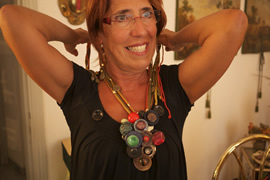STORIES
Eriberta carnali: Wearable Art
Story by Debra Hunter
Eriberta’s story as an artist began when she saved the antique buttons from her grandmother’s coat. These buttons from the past transformed Eriberta Carnali into an artist. She has woven, crocheted, and sown hundreds of discarded buttons into necklaces that create new dimensions in her life.
For 30 years, Eriberta has lived with her husband, Mario, in the same home in Cagli, Italy, a village more than 800 years old. While the top levels of their three-level home include the living and dining rooms, below are a cantina and cellar as well as a room with an ornate fireplace that serves as Eriberta’s studio.
Eriberta’s home brims top to bottom with art, paintings, small sculptures and family photographs. Butterfly motifs—a particular fascination of hers – can be seen in displays of found objects ranging from buttons to furniture. Commanding center stage is Eriberta’s jewelry. Her dining table is covered edge to edge with a landscape of white- cloth-covered cones that serve up a dazzling display of her necklaces. On a nearby settee, necklaces drape the backs and seats of the furniture, rendering them unusable for their intended purposes. In a large ceramic vase, a sturdy branch with several delicate branches displays her necklaces that have evolved into wearable works of art.
As she tells of the beginning of her artistic career and saving her grandmother’s coat buttons, Eriberta swings her arms through the air, emphasizing the inspiring memory. Eventually, she made a necklace from the buttons. Her initial efforts were interrupted by periods of inactivity. Eriberta said she gets up early in the morning because it is quiet. She enjoys this time to think about her art before the noise of the streets fills the air.
When creating her first necklaces, she used darker colors, she says, but later began using lighter colors that reflect a more-mature imagination. Initially, she gave her necklaces to friends and family. As the compliments poured in, her confidence grew. Still, she was reluctant to plunge into the professional arena. Then, the year her son graduated from college, she wore one of her necklaces while shopping in Milan. When she looked in a shop window, the owner tapped on the glass, pointing at her necklace. The rest is history. Now, she concentrates on finding buttons and making the necklaces. She leaves the marketing to others.
Eriberta says that the tiny white tag attached to each necklace is not the price but the catalog number. She brings out a small green card that identifies a piece when it is sold. In addition to that certificate, each new owner receives a record of the necklace’s origin. Also at the time of sale, each necklace is given a title with a name relevant to the new owner. Like many artists, Eriberta keeps a private collection that is not for sale, such as the original necklace made with her grandmother’s buttons and necklaces that incorporate sentimental objects that belonged to her children.
Eriberta says she has a penchant for organizing everything, which helps with her massive trove of buttons, but she adds that her orderliness drives her husband crazy. She points to the stacks of magazines under the table carefully arranged, no doubt by date. She brings out her boxes of button collections -- meticulously arranged by color and type -- with the transparent buttons in one box sorted by type.
The artist receives buttons from family and friends all over the world. She has buttons from the 1920s and buttons from more-modern times. She searches antique shops and public markets and melts plastic bottles as a creative base. She uses plastic from CDs and buckles from pants. She is currently experimenting with plastic strands, crocheting them into the necklace bands and incorporating buttons and other creative elements. Eriberta seems to recognize the symbolic value of objects, and her necklace art blends skill, intellect, discipline and vision in a combination that celebrates the people and events of her life.

